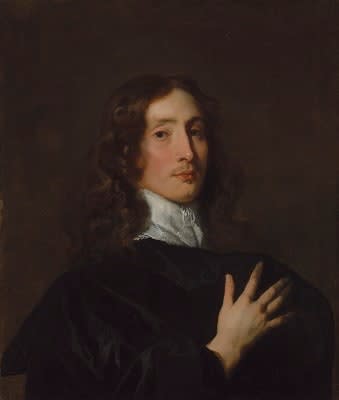
Peter Lely
Portrait of a Gentleman, Late 1640s
Oil on canvas
29 ¾ x 25 inches (75.5 x 63.5 cm)
Philip Mould & Co.
To view all current artworks for sale visit philipmould.com Sir Peter Lely’s character and talent dominated the art world of the second half of the seventeenth century in England. Though...
To view all current artworks for sale visit philipmould.com
Sir Peter Lely’s character and talent dominated the art world of the second half of the seventeenth century in England. Though Pepys famously described him as ‘a mighty proud man and full of state’, Lely’s skill for portraiture meant he assumed the mantle of Sir Anthony Van Dyck with ease. Despite sharing the stage with many accomplished painters, the particular brio of his technique and his considerable personal charm guaranteed him the most prestigious patronage. Everyone of consequence in his age sat to him, and it is in his portraits that we form our conception of the cautious solemnity of the Protectorate and the scandalous excesses of the years following the Restoration.
This portrait is an excellent example of Lely’s early style and technique, and can be dated to the late 1640s. A similarly painted work is Lely’s best known early masterpiece, The Concert [Courtauld Collection, London]. Here, the delicate lighting and soft tones of brown and black suggest that the picture is more redolent of Lely’s early education in Haarlem, Holland (under Frans Pieter de Grebber) than his later works, and shows that while Lely had by this time begun to emerge as Van Dyck’s undoubted heir, and thus the leading portraitist in England, he had not yet completely adopted the flamboyant, Royalist compositions and colouring that would eventually make him so popular. Unlike Lely’s later works, which often relied on stock compositions repeated by studio assistants, the present picture is instead somewhat idiosyncratically composed, with the sitter leaning backwards against a plain but hurriedly painted background, and gathering his cloak to his chest. These and the pentimenti visible around the sitter’s head combine to give the portrait a sense of movement and spontaneity.
Although once thought to be John Milton, the present sitter is in fact sadly unknown. It may well have been someone amongst Lely’s notable artistic and literary circle at the time, which included figures such as the celebrated poet Richard Lovelace. Recent cleaning by Philip Mould & Company has revealed that the picture is in extraordinarily good condition, and has suffered none of the abrasion, fading and over-cleaning too often found in English 17th Century portraiture. The excellent state of preservation is most noticeable in those areas of a portrait most susceptible to over-cleaning: the delicate glazes and shadows in the sitter’s face and hands are entirely as Lely left them; while the drapery, with its elegantly painted black fabric, is rendered with sophistication and the evident pleasure in handling oil paint that Lely enjoyed.
Sir Peter Lely’s character and talent dominated the art world of the second half of the seventeenth century in England. Though Pepys famously described him as ‘a mighty proud man and full of state’, Lely’s skill for portraiture meant he assumed the mantle of Sir Anthony Van Dyck with ease. Despite sharing the stage with many accomplished painters, the particular brio of his technique and his considerable personal charm guaranteed him the most prestigious patronage. Everyone of consequence in his age sat to him, and it is in his portraits that we form our conception of the cautious solemnity of the Protectorate and the scandalous excesses of the years following the Restoration.
This portrait is an excellent example of Lely’s early style and technique, and can be dated to the late 1640s. A similarly painted work is Lely’s best known early masterpiece, The Concert [Courtauld Collection, London]. Here, the delicate lighting and soft tones of brown and black suggest that the picture is more redolent of Lely’s early education in Haarlem, Holland (under Frans Pieter de Grebber) than his later works, and shows that while Lely had by this time begun to emerge as Van Dyck’s undoubted heir, and thus the leading portraitist in England, he had not yet completely adopted the flamboyant, Royalist compositions and colouring that would eventually make him so popular. Unlike Lely’s later works, which often relied on stock compositions repeated by studio assistants, the present picture is instead somewhat idiosyncratically composed, with the sitter leaning backwards against a plain but hurriedly painted background, and gathering his cloak to his chest. These and the pentimenti visible around the sitter’s head combine to give the portrait a sense of movement and spontaneity.
Although once thought to be John Milton, the present sitter is in fact sadly unknown. It may well have been someone amongst Lely’s notable artistic and literary circle at the time, which included figures such as the celebrated poet Richard Lovelace. Recent cleaning by Philip Mould & Company has revealed that the picture is in extraordinarily good condition, and has suffered none of the abrasion, fading and over-cleaning too often found in English 17th Century portraiture. The excellent state of preservation is most noticeable in those areas of a portrait most susceptible to over-cleaning: the delicate glazes and shadows in the sitter’s face and hands are entirely as Lely left them; while the drapery, with its elegantly painted black fabric, is rendered with sophistication and the evident pleasure in handling oil paint that Lely enjoyed.
Provenance
Collection of Leo Meyer, Los AngelesExhibitions
Literature
E. Larsen, 'A presumed portrait of John Milton by Anthony Van Dyck', Pantheon, XXIV, Jahrg. V., September-October 1966, p. 288 ff., as 'Anthony Van Dyck'.E. Larsen, L'Opera completa di Van Dyck 1626-1641, (Milan 1980), pp. 122-123, no. 926, fig. 926.
E. Larsen, The Paintings of Anthony Van Dyck, (Freren 1988), I, p. 266, fig. 404; II, p. 355, as 'Anthony Van Dyck'.